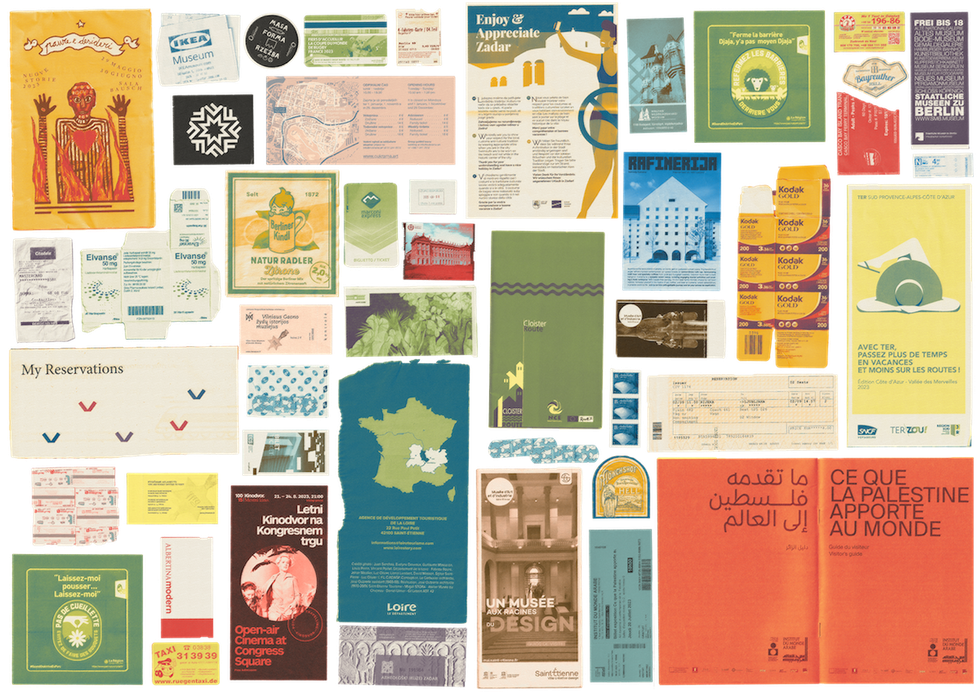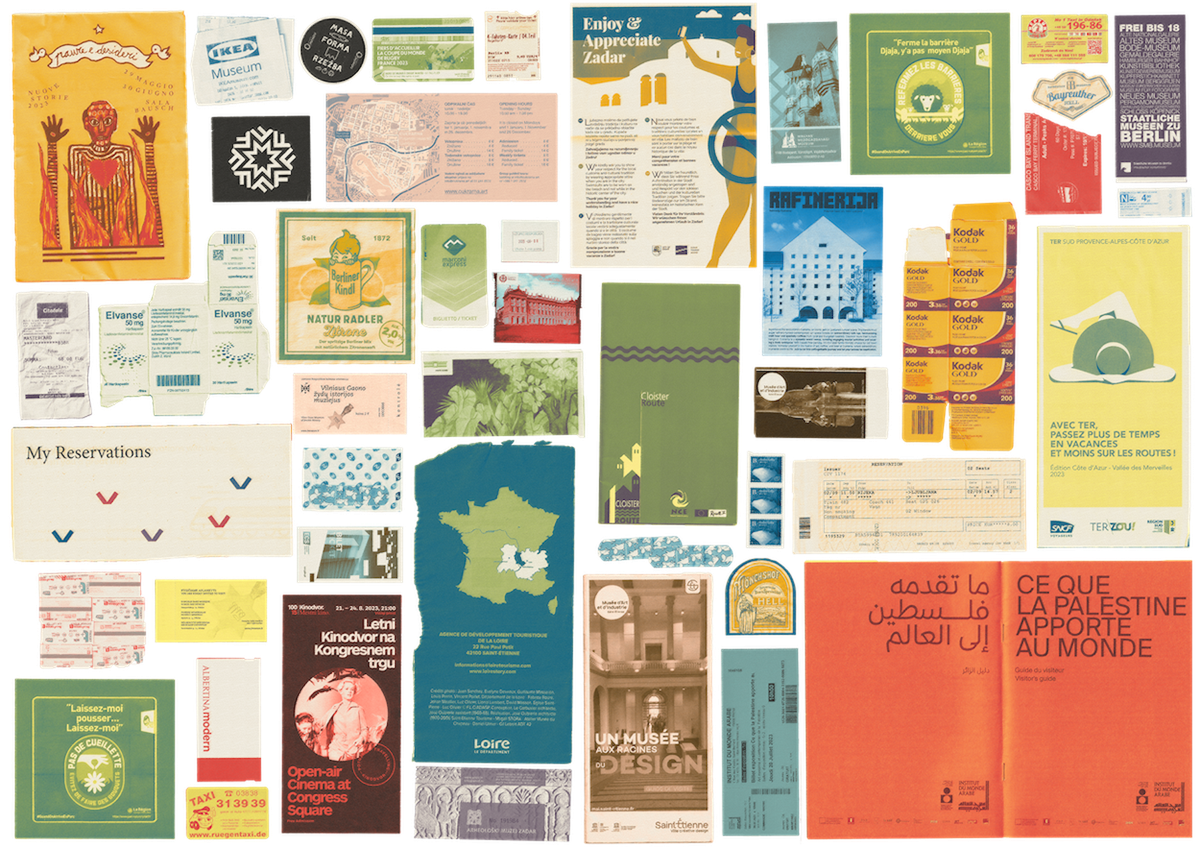[ad_1]

I’ve at all times hoped the dusty scent of the used bookstore I visited as a college pupil in upstate New York made its method into my clothes.
I’d spend hours cross-legged on the ground, itching in my wool trousers, digging by way of the containers of postcards from the final century and hoping to search out the best ones—those whose fronts marketed the locations I aspired to go to and those I longed to return to, whose backs contained essentially the most humorous and most heartbreaking messages.
The most costly postcards had been by no means greater than 4 {dollars}, however usually that was far too costly for my late-teenaged funds; however, I skipped lunches and Tecate beers to afford them.
I maintain these postcards in a binder, whose second half accommodates practice ticket stubs and museum guides and grocery lists I’ve both gathered myself or picked up off the bottom. The binder lives on my desk, which itself lives below a set of unique posters for sixties movies like La Chinoise and Fanny Hill and one framed, disintegrating sixty-year-old subject of Playboy (“Women of Russia and the Iron Curtain International locations”). Throughout, there are snow globes, match containers, embroidery from Lithuania, strips and strips of coloration movie negatives, a felt pillowcase from Hungary, and naturally, books. Possibly it’s accumulating. Possibly it’s micro-archival work. Possibly it’s simply hoarding.
At occasions, this obsession with objects feels antithetical to my politics. However I can’t deny that I actually, actually love issues.
At occasions, this obsession with objects feels antithetical to my politics. In any case, I attempt to not be a consumerist or a commodity fetishist. I dislike manufacturers, franchises, conglomerates, subsidiaries, and all of the phrases that describe firms that churn out low cost, plastic items made by exploited staff and bought to bored, unfulfilled People procuring idly on Amazon or at Goal. However I can’t deny that I actually, actually love issues.
A borderline pathological want to gather issues appears typical to the character of intellectuals, writers, and artists. Franklin Roosevelt’s assortment of stamps and miniature ships is housed at his Hudson Valley library. Andy Warhol amassed dozens of cookie jars. The good artist and illustrator Edward Gorey, identified for his macabre kids’s books and Edwardian type, had two-dozen fur coats, which he usually wore to the New York Metropolis ballet and styled with Converse sneakers; he solely stopped accumulating them (and swore off the follow) after lastly assembly a household of raccoons nesting within the coats in his attic. Umberto Eco and Walter Benjamin have each written in regards to the library-as-collection, stuffed cabinets whose volumes are prized for his or her physicality and object-ness earlier than their content material. In a speak about ebook accumulating, Benjamin advised attendees,
“Each ardour borders on the chaotic, however the collector’s ardour borders on the chaos of reminiscences. Greater than that: the prospect, the destiny, that suffuse the previous earlier than my eyes are conspicuously current within the accustomed confusion of those books . . . . To resume the previous world—that’s the collector’s deepest want when he’s pushed to accumulate new issues, and that’s the reason a collector of older books is nearer to the wellsprings of accumulating than the acquirer of luxurious editions.”
From Roosevelt to Benjamin, it’s usually those that are involved with the summary which have the strongest relationships with the tangible—accumulating isn’t opposite to left-wing thought, however emblematic of it.
Commodity fetishism sees issues as “merchandise,” issues that exist however had been by no means made, holding worth however solely in relation to the market. Amassing, then, turns into the antidote to this capitalist contagion. The will to gather is the will to know objects as automobiles for human expression, the bodily manifestation of labor, information, collaboration, and motion. Amassing, as a follow of affection and appreciation, is the antithesis of over-consumption as a result of it champions holding on to and cherishing objects as a substitute of merely throwing them away and shopping for the subsequent new factor.
The will to gather is the will to know objects as automobiles for human expression, the bodily manifestation of labor, information, collaboration, and motion.
In fact, the worth and achievement of accumulating is topic to capitalist recuperation. A latest article from The Guardian written by Amelia Tait highlighted the litany of hyper-consumers masquerading as collectors, a phenomenon which Tait keenly cash “one-in-every-color capitalism.”
Tait is thorough in interrogating the needs of those collectors of hand sanitizer, Stanley cups, and Crocs. These are essentially relationships with manufacturers, not objects, and much more so relationships with photos, cameras, and algorithms; many of those “collectors” have monetized their collections by displaying them on social media. One of many influencer-collectors that Tait writes about, New York Metropolis teenager Victoria Sepiashvili, has come to doubt the utility of her assortment. She had initially wished to make a reputation for herself on the Web as a dancer, which she describes as “my blood, my core, my basis.”
However when Sepiashvili’s dance movies didn’t deliver her Web fame, she turned to exhibiting her in depth hand sanitizer assortment. Now, Sepiashvili has complicated emotions about her assortment. What was as soon as an act of human connection, visiting the mall and bonding along with her mom over new scents and colours, is right now a perfunctory train in consumerism largely devoid of ardour. “It’s unlucky, however you must do what folks like even when it’s foolish, silly stuff,” she advised Tait, involved that her movies promote “hoarding and maximalism and simply issues, issues, issues, issues . . . . We solely have one life and issues are completely not vital.”
To me, the distinction between accumulating and “accumulating” (or, higher put, accumulating and consumption-portrayed-as-collecting) is intent. A wall of unopened branded merchandise capabilities not as a set of distinctive items, however a testomony to its personal measurement and value. Particular person objects don’t exist to serve a particular goal or show a singular voice, merely to “full” a picture.
Once I consider my previous Playboys, my overly-annotated paperbacks, my patterned classic button-downs, I don’t consider them as market commodities gaining fairness or components of a prized set. Every object has been made, used, beloved (one thing maybe finest ignored with the previous males’s magazines). The worth in proudly owning and holding these items arises from collaborating in a lineage of appreciation and craft. And maybe most significantly, that worth is unextractable, embedded into the essence and historical past of the article, one thing which arises by way of information and care, demanding an energetic connoisseurship not simply appropriated by the market.
To make sure this perspective isn’t a easy justification of my pack-rat habits, I reached out to a fellow collector to know what compels them to gather, and if their accumulating additionally felt like a reworking relationship with bodily objects. I spoke with Nathan Bloom, a twenty-five 12 months previous documentary manufacturing assistant who collects yunomis, a Japanese time period for a footed ceramic ingesting cup that’s taller than it’s vast. Whereas Bloom is keen on accumulating the works of artists he admires, it’s not a lot a reputation however a definite voice to which he’s drawn.
“My assortment won’t ever be finished,” Bloom tells me. He makes use of these cups each day, a follow that injects creative intent and human labor into on a regular basis, mundane moments. “The thing is to not be in awe of. I see these mass business ceramics; by default, the handmade items are simply a lot extra intriguing. I actually just like the mark of a maker.”
Bloom’s assortment is far more modern than mine, permitting him to talk on to the creators of his yunomi. “I need to actually, truly be with these objects,” Bloom says, describing how he sometimes has prolonged interactions with artists earlier than buying their ceramics. “Somebody put hours into this, and I’ll put in years savoring and experiencing it.”
I, ever-morbid, ask Bloom what he want to change into of his assortment as soon as he dies. He says that he would adore it if he had kids who loved the cups as a lot as he does. In any other case, he mentioned, “I might love to have the ability to go it all the way down to somebody that sees their worth. If not, I’d love them to be donated to some museum area or assortment.” I ask Bloom to outline that worth, and he tells me their worth is “that basically easy objects that you just use every single day don’t must be boring. They are often one-of-a-kind, actually particular, and you may take pleasure in ingesting out of a cup in the identical method you’d take pleasure in watching a bit of artwork on the wall.”
Whereas Bloom’s assortment has a utilitarian worth that mine lacks, he acknowledges that the artistry of those cups doesn’t improve their perform; what makes them collectable is exactly the purposeful unnecessariness of non-public expression.
Many on the left imagine minimalism is the one private reply to the political subject of overconsumption. I disagree. If progressive politics are pushed by a ardour for humanity, the progressive could be pushed to cherish, dwell on, and dwell with the bodily manifestations of our humanity.
To a collector, the worth of the article lies within the fingerprints of the maker, of the shopkeeper, and of themselves; the mix of those types the true value of an object. As Benjamin, who understood that objects maintain essentially the most emotional and political energy not in the intervening time of acquisition, however with years of considerate appreciation, as soon as wrote:
“Essentially the most profound enchantment for the collector is the locking of particular person gadgets inside a magic circle during which they’re mounted as the ultimate thrill, the joys of acquisition, passes over them. The whole lot remembered and thought, every little thing acutely aware, turns into the pedestal, the body, the bottom, the lock of his property. The interval, the area, the craftsmanship, the previous possession—for a real collector the entire background of an merchandise provides as much as a magic encyclopedia whose quintessence is the destiny of his object.”
[ad_2]


